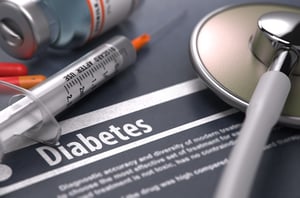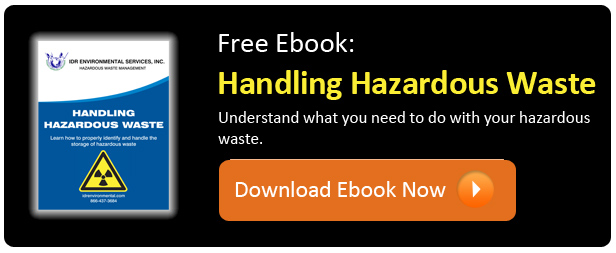Some pharmaceutical wastes are classified as hazardous wastes. Others are medical waste disposal, and still others are nonhazardous wastes.
Which category a pharmaceutical falls into depends on its chemical, physical, and toxicological properties and who generates the waste.
It is important to know which of these categories your waste falls into in order to make sure you are compliant with regulations.
The following information is taken directly from the DTSC.
Hazardous Properties of Pharmaceutical Wastes
A discarded pharmaceutical may be identified as a hazardous waste in California if it appears on a regulatory list of hazardous wastes or exhibits one of four hazardous characteristics.
Listed hazardous wastes include epinephrine, nitroglycerin, and many chemotherapy agents (40CFR Part 261).
Characteristics that make a waste a hazardous waste include:
-
Ignitability - Examples include formulations with more than 24% alcohol, collodion, and oxidizers such as potassium permanganate and silver nitrate.
-
Corrosivity - Waste that has a pH less than 2 or greater than 12.5.
-
Reactivity - An example of this is nitroglycerin, which is generally exempt from federal hazardous waste regulations, but not California hazardous waste regulations.
-
Toxicity - An example would be zinc in some shampoos, or anything containing a regulated substance at a concentration above the limit for that substance, as determined by a laboratory procedure known as the Toxicity Characteristic Leaching Procedure (TCLP).
Pharmaceuticals That Are Not Regulated As Hazardous Waste
In California, the Department of Toxic Substances Control (DTSC) is the agency authorized to regulate pharmaceutical wastes to the extent that they are regulated as hazardous waste under the federal Resource Conservation and Recovery Act (RCRA).
California’s hazardous waste laws govern the management of waste pharmaceuticals that meet the federal definition of hazardous waste found in Title 40 Code of Federal Regulation (40CFR) 261.3.
However, pharmaceutical wastes produced by households and certain small, non-household generators, known as Conditionally Exempt Small Quantity Generators (CESQGs), are not regulated as hazardous waste.
Pharmaceuticals that are Regulated as Medical Waste

Some wastes that are not regulated under RCRA – such as wastes that contain zinc and wastes produced by generators who are exempt from RCRA (such as Conditionally Exempt Small Quantity Generators) – are nevertheless identified as hazardous waste in California.
Besides the chemical and physical properties mentioned above, a number of additional factors can cause a waste to exhibit the characteristic of toxicity under California standards.
If the waste contains a substance listed in the California Code of Regulations Sections 66261.24(a)(1) and 66261.24(a)(2) at a concentration above the specified limit, the waste would be identified as a hazardous waste in California.
In addition, a waste that is toxic when inhaled, or that is fatal to certain types of fish in laboratory tests, is considered a hazardous waste in California.
Pharmaceutical wastes that meet California’s definition of hazardous waste but not RCRA’s definition, as well as pharmaceutical wastes generated by people who are not regulated under RCRA, are subject to the Medical Waste Management Act (Division 104, Part 14 California Health and Safety Code). However, pharmaceutical waste produced by a household is not regulated as hazardous waste or medical waste.
Whether or not a specific generator or activity is regulated under the Medical Waste Management Act may depend on a number of factors. If you have questions about how a specific pharmaceutical waste is regulated, or about how to comply with the Medical Waste Management Act, you should contact the California Department of Health Services’ Medical Waste Management Branch.
More information on Pharmaceuticals as Medical Waste can be found at the California Department of Health Services web page.
What Does This Mean For Larger Generators?
Businesses that generate more than 100 kg per month of RCRA regulated hazardous waste must manage their RCRA regulated pharmaceutical waste as hazardous waste. Generators are responsible for determining whether their waste pharmaceuticals are RCRA hazardous wastes.
The Florida Department of Environmental Protection working with United States Environmental Protection Agency (U.S. EPA) has developed a list of pharmaceuticals that may meet the definition of RCRA hazardous waste.
Further, the U.S. EPA has issued guidance letters for generators of waste pharmaceuticals such as doctor’s offices, clinics and hospitals utilizing reverse distribution programs for waste pharmaceuticals.
Certain pharmaceuticals generated by Small and Large Quantity Generators of RCRA waste that do not meet the Federal definition of hazardous waste may be regulated under the California Medical Waste Management Act.
The pharmaceutical wastes from business generators that would be regulated as hazardous waste or medical waste in California are those wastes that meet the definition of hazardous under California Code of Regulations, Sections 66261.3 and 66261.4.
Consulting Experts
Often, all of these hazardous waste regulations can be hard to keep up on. It is important to consult experts who can consult with you about your existing waste and disposal processes. They can help you save money, make sure your waste is disposed of properly and avoid costly fines.


Comment